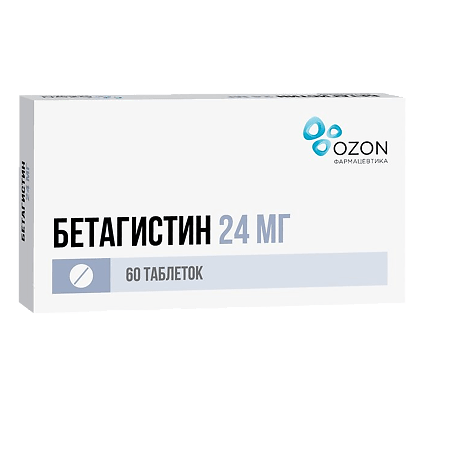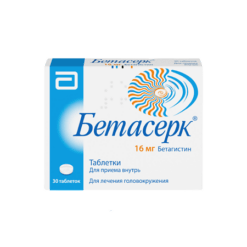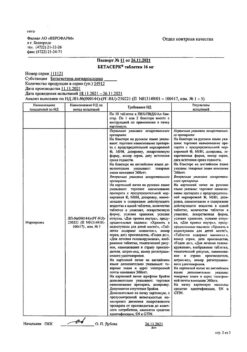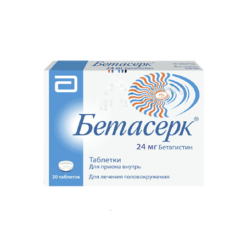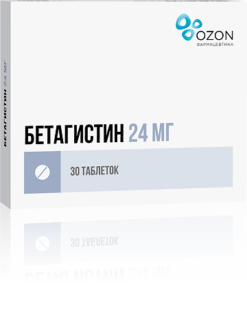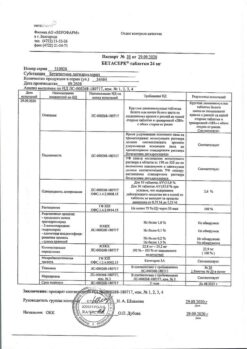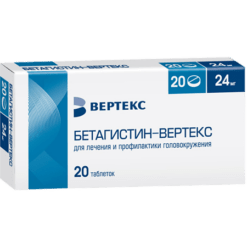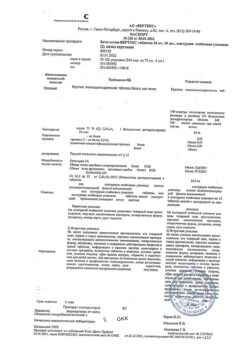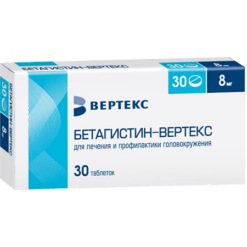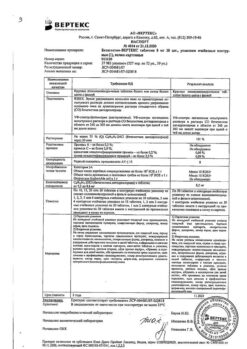No products in the cart.
Betahistine, tablets 24 mg 60 pcs
€14.86 €12.39
Description
Pharmacotherapeutic group
Histamine drug
ATX code
N07CA01
Pharmacodynamics:
An agonist of H1-histamine receptors of the inner ear vessels and an antagonist of H3-histamine receptors of the vestibular nuclei of the central nervous system (CNS). By relaxing the precapillary sphincters of the vessels of the inner ear, it improves blood circulation in the vascular band of the inner ear.
Dose-dependently reduces the generation of action potentials in the neurons of the lateral and medial vestibular nuclei.
Accelerates recovery of vestibular function after unilateral vestibular neurectomy by accelerating and facilitating central vestibular compensation (due to antagonism with H3-histamine receptors).
It alleviates symptoms in Meniere’s syndrome and vestibular vertigo.
Stable therapeutic effect occurs after 14 days.
Pharmacokinetics:
Absorbed rapidly binding to plasma proteins is less than 5%. Time of reaching maximum concentration in blood plasma (TCmax) – 1 hour.
Metabolized to inactive metabolites: 2-pyridylacetic acid (the main metabolite) and demethylbetahistine. 85-90% is excreted by the kidneys as 2-pyridylacetic acid within 24 hours. Excretion of betahistine and demethylbetahistine by the kidneys is insignificant. The intestine excretes only a small part of betahistine and its metabolites. When the drug is taken with food, the maximum concentration of betahistine is lower than when taken on an empty stomach. However, the total absorption of betahistine is the same in both cases, indicating that eating only slows absorption of betahistine.
Indications
Indications
Treatment of Meniere’s syndrome characterized by dizziness (accompanied by nausea and vomiting), hearing loss and tinnitus.
Symptomatic treatment of vestibular dizziness (vertigo).
Pharmacological effect
Pharmacological effect
Pharmacotherapeutic group
Histamine drug
ATX code
N07CA01
Pharmacodynamics:
An agonist of H1-histamine receptors in the vessels of the inner ear and an antagonist of H3-histamine receptors of the vestibular nuclei of the central nervous system (CNS). By relaxing the precapillary sphincters of the vessels of the inner ear, it improves blood circulation in the vascular striatum of the inner ear.
Dose-dependently reduces the generation of action potentials in neurons of the lateral and medial vestibular nuclei.
Accelerates the restoration of vestibular function after unilateral vestibular neurectomy by accelerating and facilitating central vestibular compensation (due to antagonism with H3-histamine receptors).
Relieves symptoms of Meniere’s syndrome and vestibular vertigo (vertigo).
A stable therapeutic effect occurs after 14 days.
Pharmacokinetics:
The connection with plasma proteins is quickly absorbed – less than 5%. Time to reach maximum concentration in blood plasma (TCmax) – 1 hour.
Metabolized to inactive metabolites: 2-pyridylacetic acid (the main metabolite) and demethylbetagistine. 85-90% is excreted by the kidneys in the form of 2-pyridylacetic acid within 24 hours. Excretion of betahistine and demethylbetagistine by the kidneys is insignificant. Only a small part of betahistine and its metabolites is excreted by the intestines. When taking the drug with food, the maximum concentration of betahistine is lower than when taken on an empty stomach. However, the total absorption of betahistine is the same in both cases, indicating that food intake only slows down the absorption of betahistine.
Special instructions
Special instructions
The therapeutic effect in some cases increases within several months from the start of treatment.
Impact on the ability to drive vehicles. Wed and fur.:
No or negligible impact.
Active ingredient
Active ingredient
Betahistine
Composition
Composition
Each tablet contains:
Active substance: betahistine dihydrochloride – 24.0 mg.
Excipients: lactose monohydrate (milk sugar) – 129.0 mg; microcrystalline cellulose – 70.5 mg; corn starch – 30.0 mg; copovidone – 27.0 mg; sodium carboxymethyl starch – 15.0 mg; colloidal silicon dioxide – 1.5 mg; magnesium stearate – 3.0 mg.
Contraindications
Contraindications
Hypersensitivity to the components of the drug pregnancy lactation period children under 18 years of age pheochromocytoma lactose intolerance lactase deficiency glucose-galactose malabsorption.
With caution:
Peptic ulcer of the stomach or duodenum (history) and bronchial asthma.
Side Effects
Side Effects
From the digestive system: nausea, dyspepsia, vomiting, abdominal pain, bloating.
Allergic reactions: hypersensitivity incl. anaphylactic reactions.
From the skin: angioedema, urticaria, itching, rash.
From the nervous system: headache.
Interaction
Interaction
The interaction of betahistine with H1-blockers when used concomitantly may theoretically affect the effectiveness of one of these drugs.
Overdose
Overdose
Symptoms: nausea, abdominal pain, drowsiness (when taken at a dose of up to 640 mg); convulsions, cardiopulmonary complications (when taken at a dose of more than 640 mg or in combination with other drugs).
Treatment: symptomatic.
Storage conditions
Storage conditions
In a dry place, protected from light, at a temperature not exceeding 25 ° C.
Keep out of the reach of children.
Shelf life
Shelf life
3 years. Do not use after expiration date.
Manufacturer
Manufacturer
Ozon, Russia
Additional information
| Shelf life | 3 years. Do not use after the expiration date. |
|---|---|
| Conditions of storage | In a dry place protected from light at a temperature not exceeding 25 ° C. Store out of the reach of children. |
| Manufacturer | Ozon, Russia |
| Medication form | pills |
| Brand | Ozon |
Other forms…
Related products
Buy Betahistine, tablets 24 mg 60 pcs with delivery to USA, UK, Europe and over 120 other countries.

